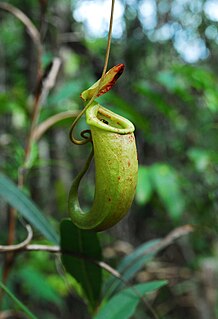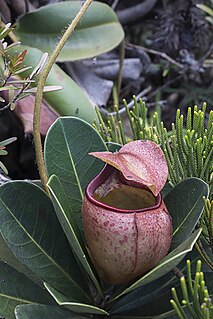
Vallaris is a genus of plants in the family Apocynaceae first described as a genus in 1768. It is native to China, the Indian Subcontinent, and Southeast Asia.
- Vallaris anceps = Kibatalia macrophylla
- Vallaris angustifolia = Kibatalia gitingensis
- Vallaris arborea = Kibatalia macrophylla
- Vallaris clavata = Echites clavatus
- Vallaris daronensis = Kibatalia maingayi
- Vallaris divaricata = Strophanthus divaricatus
- Vallaris fimbriata = Euphorbia mammillaris
- Vallaris gitingensis = Kibatalia gitingensis
- Vallaris ipecacuanhae = Euphorbia ipecacuanhae
- Vallaris lancifolia = Vallariopsis lancifolia
- Vallaris laxiflora = Pottsia laxiflora
- Vallaris macrantha = Beaumontia macrantha
- Vallaris maingayi = Kibatalia maingayi
- Vallaris missurica = Euphorbia missurica
- Vallaris portulacoides = Euphorbia portulacoides
- Vallaris × uniflora = Euphorbia × uniflora

Nepenthes sibuyanensis is a tropical pitcher plant endemic to Sibuyan Island in the Philippines, after which it is named.

Nepenthes mindanaoensis is a tropical pitcher plant native to the Philippine islands of Mindanao and Dinagat.

Nepenthes merrilliana is a tropical pitcher plant endemic to the Philippines. It produces some of the largest pitchers in the genus, rivalling those of N. rajah.

Nepenthes bellii is a tropical pitcher plant endemic to the Philippine islands of Mindanao and Dinagat, where it grows at elevations of 0–800 m above sea level.
Nepenthes × merrilliata is a natural hybrid involving N. alata and N. merrilliana. Like its two parent species, it is endemic to the Philippines, but limited by the natural range of N. merrilliana to Samar as well as Mindanao and its offshore islands.

Nepenthes surigaoensis is a tropical pitcher plant endemic to the Philippine island of Mindanao, where it grows at elevations of at least 800–1200 m above sea level.
Nepenthes × tsangoya is a tropical pitcher plant. It reportedly represents the complex natural hybrid × N. mirabilis.
Kibatalia borneensis is a species of plant in the family Apocynaceae. It is endemic to the state of Sarawak, part of Malaysia on the island of Borneo. It is threatened by habitat loss.
Kibatalia elmeri is a species of plant in the family Apocynaceae. It is endemic to the island of Luzon in the Philippines.
Kibatalia gitingensis is a species of plant in the family Apocynaceae. It is endemic to the Philippines.
Kibatalia longifolia is a species of plant in the family Apocynaceae. It is endemic to the Philippines.
Kibatalia macgregori is a species of plant in the family Apocynaceae. It is endemic to the Philippines.
Kibatalia puberula is a species of plant in the family Apocynaceae. It is endemic to the Philippines.
Kibatalia stenopetala is a species of plant in the family Apocynaceae. It is endemic to the Philippines.
Kibatalia villosa is a species of plant in the family Apocynaceae. It is found in Indonesia and Malaysia.
Kibatalia wigmani is a species of plant in the family Apocynaceae. It is a tree endemic to Sulawesi in Indonesia. It is a vulnerable species threatened by habitat loss.

Kibatalia arborea is a tree in the dogbane family Apocynaceae.
Nepenthes samar is a tropical pitcher plant native to the Philippines. It is known only from the island of Samar, after which it is named. It is closely allied to N. merrilliana.

Nepenthes erucoides is an ultramaficolous tropical pitcher plant endemic to Mount Redondo, the highest peak on the Philippine island of Dinagat, where it occurs from c. 800 m to the summit at 929 m. It grows on a very thin substrate consisting of "lateritic nickel ore and decomposed chromite rubble, through to a clay derived thereof", which has been described as the most extreme ultramafic substrate known to host Nepenthes. Its taxonomic affinities are unclear, though it has been noted for its similarities to N. mantalingajanensis from Palawan. The species' ultramaficolous ecological setting has permitted the radiation of a peculiar set of associated traits, those being: "reduced leaf morphologies, sclerophyllous characteristics, hirsuteness and small stature", which have been associated similarly with the diminutive Nepenthes argentii of the windswept, ultramafic peak of Mount Guiting-Guiting, Sibuyan. The authors suggest that morphological analogues in the aforementioned species do not entail genetic association, and as such these may be considered as instances of morphological convergence- derived from associated conditions in ultramaficolous ecology- until further genetic analysis occurs. Nepenthes erucoides co-localizes with N. mindanaoensis and N. bellii. Nepenthes truncata occurs within the extent of the elfin forest below the 800 meter elevation band, N. merrilliana occurring regionally at elevations below 600 meters.








